

Tom and I have returned to McMurdo Station!
Our traverse is complete, our gear has been stored for next season, and we are ready to head north to warmer climates. But in the meantime, we are awaiting our flight to Christchurch, New Zealand, at Antarctica’s largest research station.

McMurdo Station from above (Photo: Tom Neumann)
McMurdo is one of three permanent US research stations in Antarctica. The other two are Amundsen-Scott South Pole Station and Palmer Station, which is south of South America. McMurdo has beds for approximately 1,000 people, but while we have been here, the population has hovered between about 750 and 825.
While there is a research station operated by New Zealand just 2 km away, McMurdo is relatively isolated. As such, there are facilities here that provide all of the basic essentials required for living in the polar regions, such as power, heat, and water. McMurdo has its own diesel-based power plant, providing lights and heat to the station. The station gets its fresh water through the desalinization of the sea water in the neighboring bay via a method called reverse osmosis. And McMurdo has its own waste-water treatment facility. To operate a station this size, and in this environment, McMurdo also requires an airfield, a galley, and all of the staffing that goes along with running a small town. It is quite an operation.
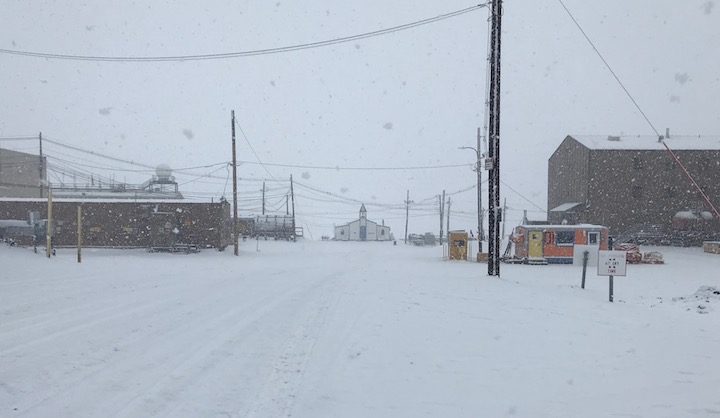
McMurdo on a snowy day, with the chapel in the background. (Photo: Kelly Brunt)
McMurdo station also has specialized facilities that support the cutting-edge science that happens here. These facilities include a sophisticated laboratory that is capable of housing a cross section of Antarctic research disciplines such as glaciology, geology, meteorology, and biology.
The research that takes place here also includes really cool meteorite science! The search for meteorites is a bit simpler here than in other parts of the world. Since Antarctica is a thick sheet of ice, rocks found on the top of the ice sheet are often associated with debris fallen from space; these meteorites stand out against the white surface. Plus, the flow of the ice organizes the meteorites, making them more centralized for collection. Some of our colleagues from NASA Goddard Space Flight Center are part of this effort.
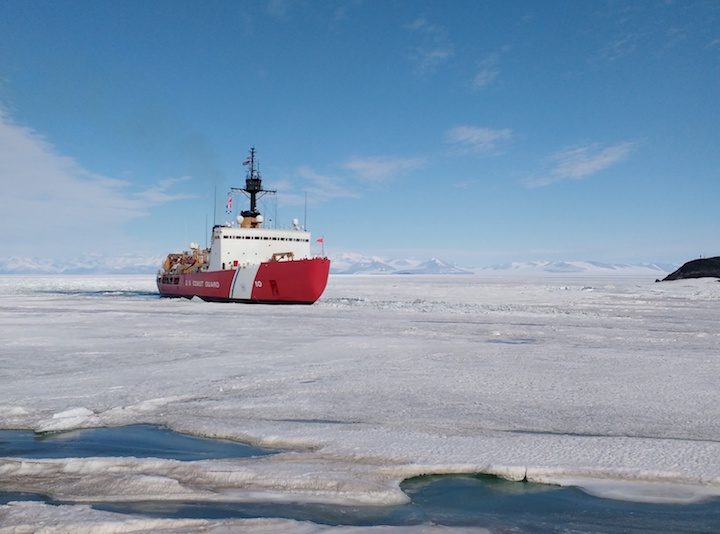
The U.S. Coast Guard Cutter Polar Star, in McMurdo Sound. (Photo: Tom Neumann)
The pier in town is currently the busiest spot on station. The US Coast Guard Cutter Polar Star has cleared a channel into McMurdo Sound, giving three other vessels access to town. The first is the Nathaniel B. Palmer, the US Antarctic Program’s premier research vessel, which has been in town for the past few days. Simultaneously, the entire station is preparing for the arrival of the two other ships: the tanker Maersk Peary brings in the annual fuel supply, and the Ocean Giant cargo ship brings in the food and supplies for the following year.
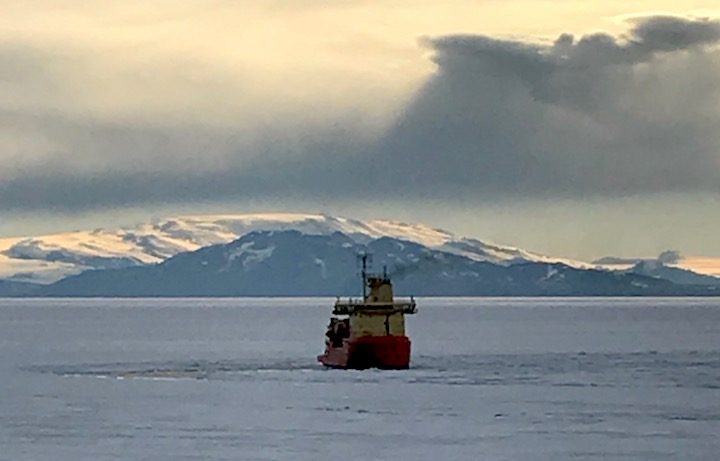
The Nathaniel B. Palmer in McMurdo Sound (Photo: Kelly Brunt)
Tom and I are scheduled to leave McMurdo on the next flight. But the weather has deteriorated and we are left patiently waiting for it to clear. We are extremely happy with our successful field season and have had a fantastic trip. Thanks for reading and following along.
-Kelly & tom
By Ryan Walker
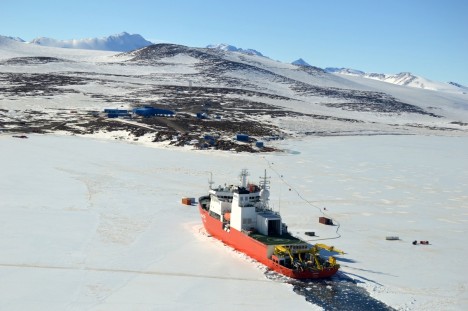
Credit: NASA/Christine Dow
Before it was time to recheck our GPS stations and download data from them, the icebreaker Araon arrived at Jang Bogo, bringing new scientists, a new helicopter crew, fresh food, and other supplies. Because of heavy sea ice cover on the bay, the arrival was in slow motion, taking most of a day from the time the ship was visible from the station until it stopped a few hundred yards offshore due to unbreakable eight-foot-thick ice. Thick ice often requires an icebreaker to back up a considerable way, then charge forward into the ice, breaking through either by pure impact or by sliding the bow up onto the ice, causing it to collapse under the ship’s weight. One passenger told Christine and me that it was “like being in a car crash — all day.” We’re quite happy that there will already be a clear path out of the bay when we take the Araon back to Christchurch. Before leaving again for a roughly week-long science cruise, the ship also dropped off quite a lot of equipment for the various science teams, including most of the instruments to be installed by our hosts, the Extreme Geophysics Group. This meant that the time between Araon’s departure and return would be very busy, with limited time to install instruments before most of the scientists leave on the ship. On top of this, we had several days of bad weather that prevented any helicopter flights. In order to finish our work on the GPS stations, we had to squeeze into a busy flight schedule, which meant that Christine and I would go on separate flights.
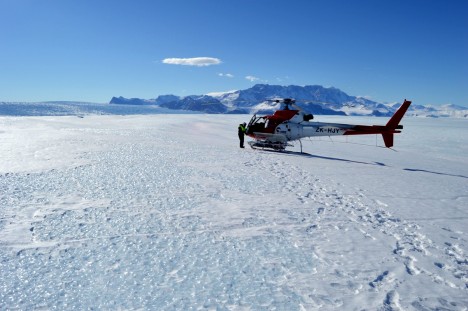
Credit: NASA/Christine Dow
I was on the first flight on December 10, which began with Dr. Choon-ki Lee installing a new GPS station on a large piece of ice at the front of Nansen Ice Shelf that looks ready to calve off into a tabular iceberg. There’s a huge crack, miles long and sometimes over a hundred yards wide, which runs more or less parallel to the front of the ice shelf. Over the winter, the sea surface freezes and traps small icebergs in the crack, producing a fascinatingly broken icescape. Comparing ice velocities between this new GPS and our stations should let us monitor the calving process and learn more about how it works. When we moved on to check the first of our GPS stations, I found that it wasn’t operating at all. After checking the wiring, I worked out that the problem was either in the wire to the receiver, the regulator (the electrical component that connects the solar panel, battery, and receiver), or the GPS receiver itself (potentially big trouble) — but had no idea which one. I pulled out those three components to check back at Jang Bogo, and we secured the rest of the station and moved on. Fortunately, after an unpromising start, the two other GPS stations we visited were working perfectly. While downloading the data, which involved about fifteen minutes of connecting my laptop and then sitting on the ice typing obscure commands, I was amused by how much this aspect of field work resembled the computer modeling work I usually do, though with vastly better scenery. We then returned to Jang Bogo with two stations in good shape, two yet to be checked, and one hopefully to be repaired.
Christine says: It was getting worryingly close to the time when we would be leaving the Antarctic and we still had some data to collect and the GPS to fix. I found that the GPS problem had been due to a faulty solar regulator and replaced it with a spare back at base. Luckily I managed to piggy back on a flight out to the Nansen Ice Shelf with the Extreme Geophysics Group while they were putting out seismic stations. Replacing the GPS was quick, with the satellite lights blinking encouragingly; now we just have to hope the system will continue working for the next couple of months. At the next station, I downloaded the data while wind blew some loose snow all over me and the computer. I probably looked a little like a snowman by the end of that. The final job was to replace the tethers on the last GPS (see our previous blog post). It was not without sadness that I waved goodbye to the plucky little machines, which would sit out on the ice on their own until the end of February. At that stage one of our Korean colleagues who is overwintering at Jang Bogo will collect them for us and send them back on the ship.
Speaking of the ship, we’re off. It is due to arrive tomorrow and we will set sail for our 7-10 day ‘cruise’ back to Christchurch in New Zealand. Its hard to believe we’ve been here 5 weeks already and it feels a bit strange to be packing up and leaving. We’re hoping for some wildlife spottings on the boat and more importantly not to be completely debilitated by sea sickness. Internet is not readily available on the Araon so we will report back when we reach dry land. Wish us luck!
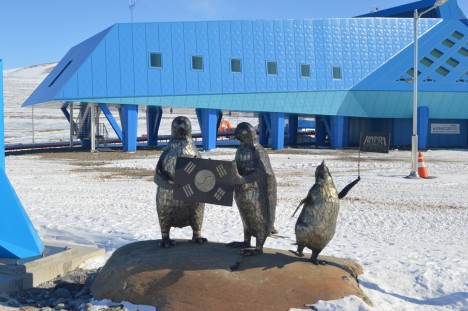
Goodbye, Jang Bogo! (Credit:NASA/Christine Dow)